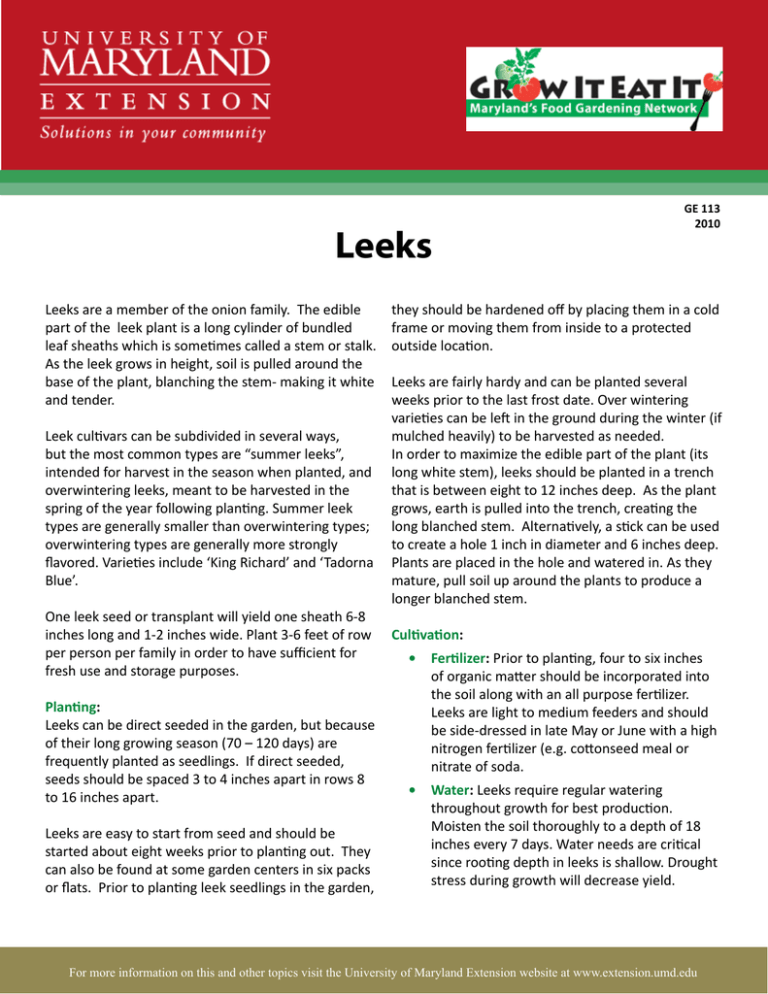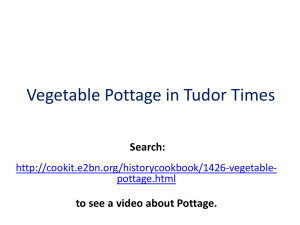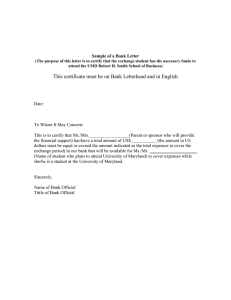Leeks
advertisement

Leeks Leeks are a member of the onion family. The edible part of the leek plant is a long cylinder of bundled leaf sheaths which is sometimes called a stem or stalk. As the leek grows in height, soil is pulled around the base of the plant, blanching the stem- making it white and tender. Leek cultivars can be subdivided in several ways, but the most common types are “summer leeks”, intended for harvest in the season when planted, and overwintering leeks, meant to be harvested in the spring of the year following planting. Summer leek types are generally smaller than overwintering types; overwintering types are generally more strongly flavored. Varieties include ‘King Richard’ and ‘Tadorna Blue’. One leek seed or transplant will yield one sheath 6-8 inches long and 1-2 inches wide. Plant 3-6 feet of row per person per family in order to have sufficient for fresh use and storage purposes. Planting: Leeks can be direct seeded in the garden, but because of their long growing season (70 – 120 days) are frequently planted as seedlings. If direct seeded, seeds should be spaced 3 to 4 inches apart in rows 8 to 16 inches apart. Leeks are easy to start from seed and should be started about eight weeks prior to planting out. They can also be found at some garden centers in six packs or flats. Prior to planting leek seedlings in the garden, GE 113 2010 they should be hardened off by placing them in a cold frame or moving them from inside to a protected outside location. Leeks are fairly hardy and can be planted several weeks prior to the last frost date. Over wintering varieties can be left in the ground during the winter (if mulched heavily) to be harvested as needed. In order to maximize the edible part of the plant (its long white stem), leeks should be planted in a trench that is between eight to 12 inches deep. As the plant grows, earth is pulled into the trench, creating the long blanched stem. Alternatively, a stick can be used to create a hole 1 inch in diameter and 6 inches deep. Plants are placed in the hole and watered in. As they mature, pull soil up around the plants to produce a longer blanched stem. Cultivation: • Fertilizer: Prior to planting, four to six inches of organic matter should be incorporated into the soil along with an all purpose fertilizer. Leeks are light to medium feeders and should be side-dressed in late May or June with a high nitrogen fertilizer (e.g. cottonseed meal or nitrate of soda. • Water: Leeks require regular watering throughout growth for best production. Moisten the soil thoroughly to a depth of 18 inches every 7 days. Water needs are critical since rooting depth in leeks is shallow. Drought stress during growth will decrease yield. For more information on this and other topics visit the University of Maryland Extension website at www.extension.umd.edu • Weeds: Control weeds through regular cultivation but avoid damaging the shallow roots of your leek plants. Weed control is particularly important during the first 2 months of growth when plants are growing slowly and compete poorly with weeds. Mulching with compost, grass clippings, or shredded leaves saved from the fall, will conserve water and smoother weeds. Harvesting: Dig or pull. Leeks have large root systems so digging is sometimes easier. Leek varieties vary in their maturity times. Leeks may be harvested as early as 60 days after planting but generally require 100-120 days to mature. Leeks are ready to eat when the stalks are 1 inch in diameter. Storage and Preservation: Long-term, leeks are best overwintered in the garden and dug as necessary. Hill up the soil around the plants and cover them with a heavy layer of mulch. Leeks can be stored for 7 to 10 days in a refrigerator. Nutrition: Source of Vitamins C & A, and folate Preparation & Use: Choose firm, stalks without withered tops. Remove tough, green tops, slice lengthwise and rinse thoroughly to remove sandy soil they are grown in. Cut into pieces and sauté or use in recipes. Authors: Jon Traunfeld, Extension Specialist, Vegetables & Fruits; Kent Phillips and Peggy Yen, University of Maryland Extension Master Gardeners; March 2010 Do you have a plant or insect pest question? Visit us at extension.umd.edu/hgic and click Ask Maryland’s Garden Experts Author: Jon Traunfeld, University of Maryland Extension Specialist, Vegetables & Fruits, Home and Garden Information Center; Kent Phillips and Peggy Yen, University of Maryland Extension Master Gardeners This publication, GE113, is a series of publications of the University of Maryland Extension and The Home and Garden Information Center. For more information on related publications and programs, http://extension.umd.edu/hgic. Please visit http://extension.umd.edu/ to find out more about Extension programs in Maryland. The University of Maryland, College of Agriculture and Natural Resources programs are open to all and will not discriminate against anyone because of race, age, sex, color, sexual orientation, physical or mental disability, religion, ancestry, or national origin, marital status, genetic information, or political affiliation, or gender identity and expression. For more information on this and other topics visit the University of Maryland Extension website at www.extension.umd.edu 2

